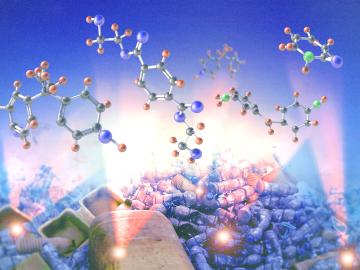
Filter News
Area of Research
- Advanced Manufacturing (8)
- Biology and Environment (7)
- Energy Science (25)
- Fusion and Fission (1)
- Fusion Energy (2)
- Isotopes (1)
- Materials (44)
- Materials for Computing (9)
- Neutron Science (5)
- Nuclear Science and Technology (4)
- Quantum information Science (1)
- Supercomputing (3)
- Transportation Systems (1)
News Type
News Topics
- (-) Materials (45)
- (-) Materials Science (49)
- (-) Mercury (7)
- (-) Molten Salt (5)
- (-) Physics (20)
- 3-D Printing/Advanced Manufacturing (47)
- Advanced Reactors (15)
- Artificial Intelligence (25)
- Big Data (29)
- Bioenergy (40)
- Biology (48)
- Biomedical (24)
- Biotechnology (11)
- Buildings (31)
- Chemical Sciences (22)
- Clean Water (21)
- Composites (14)
- Computer Science (56)
- Coronavirus (17)
- Critical Materials (14)
- Cybersecurity (9)
- Emergency (1)
- Energy Storage (45)
- Environment (88)
- Exascale Computing (4)
- Fossil Energy (1)
- Frontier (4)
- Fusion (18)
- Grid (29)
- High-Performance Computing (23)
- Hydropower (8)
- Irradiation (2)
- Isotopes (18)
- ITER (4)
- Machine Learning (24)
- Mathematics (8)
- Microscopy (22)
- Nanotechnology (18)
- National Security (20)
- Neutron Science (37)
- Nuclear Energy (35)
- Partnerships (4)
- Polymers (15)
- Quantum Computing (6)
- Quantum Science (16)
- Security (8)
- Simulation (17)
- Space Exploration (10)
- Statistics (1)
- Summit (10)
- Transportation (48)
Media Contacts

As the focus on energy resiliency and competitiveness increases, the development of advanced materials for next-generation, commercial fusion reactors is gaining attention. A recent paper examines a promising candidate for these reactors: ultra-high-temperature ceramics, or UHTCs.
Fehmi Yasin, inspired by a high school teacher, now researches quantum materials at Oak Ridge National Laboratory, aiming to transform information technology with advanced imaging techniques.

Chad Parish, a senior researcher at ORNL, studies materials at the atomic level to improve nuclear reactors. His work focuses on fusion and fission energy, using microscopy and collaborating with experts to advance materials for extreme environments.

Researchers have developed and 3D printed the lightest crack-free alloy capable of operating without melting at temperatures above 2,400 degrees Fahrenheit, which could enable additively manufactured turbine blades to better handle extreme temperatures, reducing the carbon footprint of gas turbine engines such as those used in airplanes.

Distinguished materials scientist Takeshi Egami has spent his career revealing the complex atomic structure of metallic glass and other liquids — sometimes sharing theories with initially resistant minds in the scientific community.

Oak Ridge National Laboratory scientists have developed a method leveraging artificial intelligence to accelerate the identification of environmentally friendly solvents for industrial carbon capture, biomass processing, rechargeable batteries and other applications.

ORNL scientists develop a sample holder that tumbles powdered photochemical materials within a neutron beamline — exposing more of the material to light for increased photo-activation and better photochemistry data capture.

ORNL researchers used electron-beam additive manufacturing to 3D-print the first complex, defect-free tungsten parts with complex geometries.

An international team using neutrons set the first benchmark (one nanosecond) for a polymer-electrolyte and lithium-salt mixture. Findings could produce safer, more powerful lithium batteries.

Almost 80% of plastic in the waste stream ends up in landfills or accumulates in the environment. Oak Ridge National Laboratory scientists have developed a technology that converts a conventionally unrecyclable mixture of plastic waste into useful chemicals, presenting a new strategy in the toolkit to combat global plastic waste.


